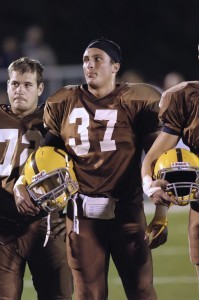Blog: Brown Beginnings, Issue 3
As the release of the non-fiction book The Boys in Brown approaches, author Jon J. Kerr takes readers inside the process. On Tuesdays, the series Brown Beginnings gives readers a behind-the-scenes look at the conception and reporting of the story. Thursdays, he blogs about the writing and publishing steps before launch.
For football fans, each season begins on a specific date. That date is the day or night of the first game. Week 1.
But for players and coaches, the season begins much sooner.
The video above was taken inside Carmel’s Salvi Gym in June of 2010. It was over two months before the Corsairs played their first game that season. At first glance, the screen is a chaotic mess–guys in shorts and t-shirts shouting and yelling. And, yes, that’s what is going on. But what appears to be a scene of disorder is actually quite structured and purposeful in its intent.
July is often a month when football teams hold pre-season camps. Varsity players (mostly juniors and seniors) are evaluated on their ability to execute the ABC’s of the sport–blocking, tackling (although less of this now), and running plays. It’s a time for players to show coaches how well they’ve worked on their football skills in the offseason. Coaches make their first depth charts. There is an urgency to practices as the upcoming season is now merely weeks away. Carmel’s program is no different.
The best stories highlight the uniqueness about a person, place or thing. Neil Hayes’ 2003 book When the Game Stands Tall featured the DeLaSalle Spartans of Concorde, California. The Spartans set a national record for most consecutive victories. Hayes wrote about how DeLaSalle did it, how it accomplished such a never-before-done milestone. The streak was the hook, the differentiator.
Carmel didn’t have a streak before 2010. It had won a state championship (2003), and a lot of football games over the previous 10 seasons. But there was no obvious uniqueness. I had spent enough time around the program to know there was something different about the culture. I just couldn’t put my finger on it. This opaqueness, the mystery, is what attracted me to the place. The best stories are often woven from the strands of the banal.
When Head Coach Andy Bitto invited me to what he referred to as “Lock-In”, he added this disclaimer:
“Some of it may appear to be tedious at times but there’s a point. What goes on has a lot to do with how successful our season will be.”
So I went. Here’s an excerpt from the book about that evening:
It’s 10 weeks away from Carmel’s season opener. No official practices have been held but this night is of utmost importance to the success of the 2010 campaign. Referred by Carmel’s coaches as “Lock In,” the activities are part of an all-night retreat with players from the junior and senior classes. Think indoor dude ranch meets Tony Robbins seminar, minus the livestock and walking on fire. Michael Fitzgibbons started ‘Lock In’ when he was head coach and now-head coach Andy Bitto uses it as a Pre-Cana for football players, a measuring stick for determining how his guys will get along on and off the field. Team chemistry is vital if Carmel is to reach its goal: to repeat as East Suburban Catholic Conference champions.
During one exercise, groups of ten form a human knot by clasping the hand of the person across from them. They must somehow untangle the labyrinth of arms and fingers without unclasping their grip. Coach Bitto is particularly interested in one group of snarled, twisted limbs. Within this group is senior-to-be Luke Venegoni. He stands 6-2 and wears a white T-shirt with “House of Speed” printed in front and a thin red bandana wrapped around his forehead. Luke possesses the classic tall, lean, muscular build for Carmel’s speed-based defensive system. With dark features—a mix of his German mother and Italian father—Luke is straight out of football linebacker central casting, commanding a room with a luminous presence that speaks: “Listen to me. I’ve been here before.”
And he has. Luke is the third Venegoni brother to play at Carmel. Showing the independent streak of a youngest child, he’s the only one not to play quarterback. His brothers liked having the ball in their hands, in control of a play’s outcome. As dutiful younger brothers often do, Luke tried at first to be like his older siblings. In grade school, he attempted to play quarterback. But he kept fumbling the ball when it was snapped. He soon discovered to trust his instincts and follow his heart. He liked to hit people. A perfect trait for a linebacker.
But at the moment, Luke’s not thinking about bloodlines or shedding blockers. He’s just trying to keep this creatural pretzel civilized.
“Georgan! You have to jump through here! I have to go under this and under there,” he says, trying to sound authoritative in what appears to be a doomed exercise.
Successful teams must have leaders. Those athletes must first be put in situations where that authority can be revealed. It is then up to the athlete to earn respect from his teammates, to be considered a leader. That night in June, doing exercises far from what you would call traditional football fundamentals, I saw Luke Venegoni emerge from the pack. There were others as well.
Big picture, what I got from that night was a taste of uniqueness. A glance into what made Carmel different. And it had nothing to do with blocking and tackling.





